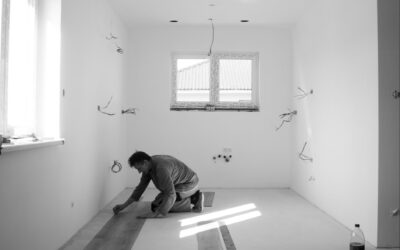Proper hardwood floors are especially expensive and this is why people turn to alternatives like LVT flooring and engineered wood. But, that in itself makes a conundrum… which is the better option of the two?
In this article, I look at the LVT vs engineered wood debate so you can understand both flooring types, their pros and cons, and ultimately get a high-quality, but affordable alternative to real hardwood planks.
Understanding LVT (Luxury Vinyl Tiles)
What is LVT Flooring?
Luxury vinyl tiles are a type of flooring made primarily from PVC and are meant to mimic traditional hardwood or stone floors. They are available either in a tile or plank configuration, in a huge range of colours and patterns, and are durable and mostly water resistant.
Advantages of LVT Flooring
LVT flooring looks fantastic and a great benefit is the immense range of colours and styles. Brands we sell like Luvanto and Karndean come in shades of beige, brown, and grey to name a few and mimic stone, parquet, and a wide variety of woods.
These tiles and planks are also especially easy to install compared to carpets and proper wood flooring and in the case of click LVT, you can do it yourself without any adhesive. Compared to engineered wood, LVT flooring is also water-resistant and copes much better in rooms like bathrooms where there is a higher moisture content.
Limitations of LVT Flooring
Despite its brilliance, LVT flooring typically has a shorter lifespan compared to engineered wood and solid wood floors. Repairs are not particularly easy either as you have to remove entire planks or tiles which can be time-consuming and affect the lay of the floor.
Best Use Cases for LVT
LVT can be used anywhere! There isn’t really a room in your house where you couldn’t potentially use it. It works great in living rooms and kitchens, and due to the protective top layers with UV protection, it is fantastic for conservatories too. In the LVT vs engineered wood argument, LVT wins hands down in terms of flexibility of usage.
Exploring Engineered Wood Flooring
What is Engineered Wood Flooring?
Engineered wood aims to provide a real wood floor but for a much cheaper price compared to solid hardwood flooring. How is this done? Instead of solid planks, engineered wood planks have a top and bottom layer made from real wood, while the core is made from layers of cheap plywood. The result looks great, and like LVT there is a range of styles, wood types, and quality levels.
Benefits of Engineered Wood Flooring
Engineered wood obviously looks more realistic than LVT flooring as it uses real wood! Therefore, if you want realism, it’s the best choice. Compared to solid wood floors, it’s generally more resistant to moisture effects and humidity too.
Engineered wood is also in most instances less expensive than solid wood, although the price varies and there are lots of different tiers of engineered wood quality.
Drawbacks of Engineered Wood Flooring
The obvious drawback of engineered wood is that it still isn’t solid wood flooring and it’s not as good quality as a hardwood floor. The internal plywood layers reduce the quality. Additionally, depending on the quality, it can be as expensive as solid wood so is not really a budget-friendly option. It’s more difficult to maintain too, and is more susceptible to wear and tear, scratches, and dents.
Ideal Applications for Engineered Wood
Generally, engineered wood flooring is better suited in areas with less foot traffic and quieter rooms such as studies, sitting rooms, and bedrooms. This is because of the increased susceptibility to scratches and dents. It’s not really suitable for bathrooms or rooms with higher moisture either compared to LVT flooring, although it does cope better in these areas than solid wood.
Key Considerations for Choosing Between LVT and Engineered Wood
When looking at LVT vs engineered wood there are some key considerations that will help you decide which is the best option:
- Budget.
- Time constraints.
- Durability.
- Longevity.
Oftentimes cost is the deciding factor and if you want an affordable product that is still high quality, LVT flooring is the better choice. You will save per square meter compared to engineered wood and to get the same cost engineered wood floor, the quality would be reduced.
Next, time constraints are something to consider and if you are working against the clock, again, LVT is the better choice. It’s well-known for its ease of installation and products like LVT click flooring don’t require adhesive and can be laid on various subfloor types.
Durability and longevity are also key factors and in this instance, we have a tie. LVT flooring is more durable and resistant to wear and tear, but engineered wood flooring lasts longers and is more akin to solid hardwood flooring in terms of lifespan.









